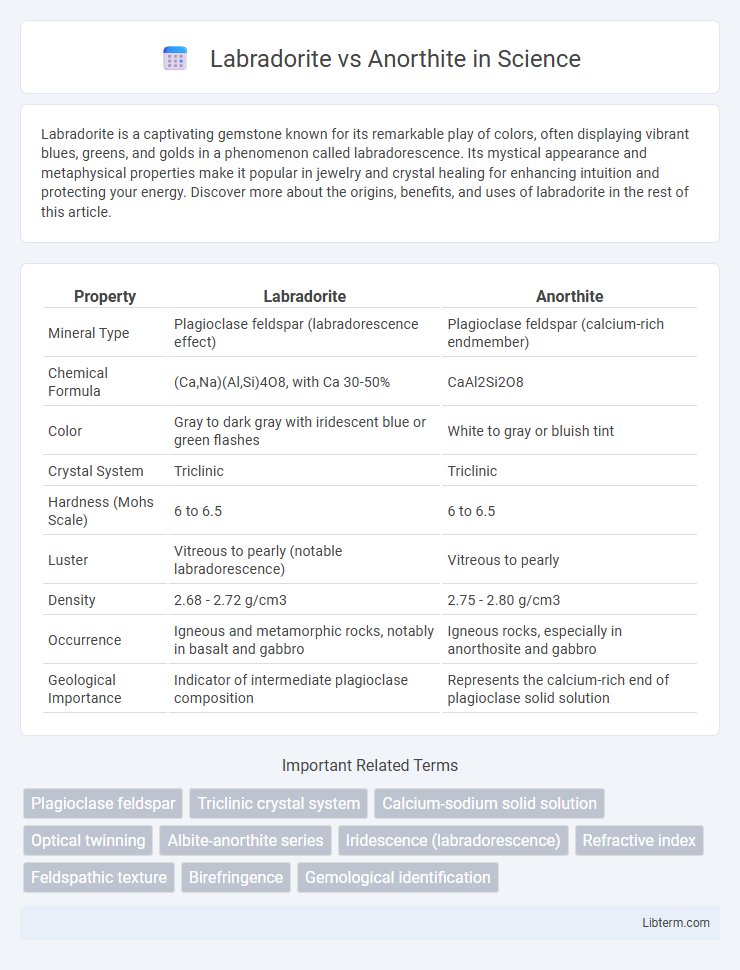Labradorite is a captivating gemstone known for its remarkable play of colors, often displaying vibrant blues, greens, and golds in a phenomenon called labradorescence. Its mystical appearance and metaphysical properties make it popular in jewelry and crystal healing for enhancing intuition and protecting your energy. Discover more about the origins, benefits, and uses of labradorite in the rest of this article.
Table of Comparison
| Property | Labradorite | Anorthite |
|---|---|---|
| Mineral Type | Plagioclase feldspar (labradorescence effect) | Plagioclase feldspar (calcium-rich endmember) |
| Chemical Formula | (Ca,Na)(Al,Si)4O8, with Ca 30-50% | CaAl2Si2O8 |
| Color | Gray to dark gray with iridescent blue or green flashes | White to gray or bluish tint |
| Crystal System | Triclinic | Triclinic |
| Hardness (Mohs Scale) | 6 to 6.5 | 6 to 6.5 |
| Luster | Vitreous to pearly (notable labradorescence) | Vitreous to pearly |
| Density | 2.68 - 2.72 g/cm3 | 2.75 - 2.80 g/cm3 |
| Occurrence | Igneous and metamorphic rocks, notably in basalt and gabbro | Igneous rocks, especially in anorthosite and gabbro |
| Geological Importance | Indicator of intermediate plagioclase composition | Represents the calcium-rich end of plagioclase solid solution |
Introduction to Labradorite and Anorthite
Labradorite is a feldspar mineral known for its striking play of colors called labradorescence, primarily composed of sodium calcium aluminum silicate. Anorthite, a calcium-rich endmember of the plagioclase feldspar series, lacks the iridescent quality but is significant in geological studies due to its high calcium content and formation in igneous rocks. Both minerals share a similar crystal structure but differ in chemical composition and optical characteristics, making them valuable for mineralogical identification and application.
Mineral Classification and Structure
Labradorite and anorthite both belong to the feldspar mineral group, specifically classified as plagioclase feldspars. Labradorite features a composition between approximately 50% to 70% anorthite content, characterized by a triclinic crystal system with notable labradorescence caused by light diffraction within its layered structure. Anorthite is the calcium-rich end-member of the plagioclase series, crystallizing in the triclinic system and distinguished by its higher calcium content and more uniform crystal lattice compared to labradorite.
Chemical Composition Differences
Labradorite and Anorthite are both feldspar minerals with distinct chemical compositions; Labradorite is a calcium-sodium plagioclase feldspar with the formula (Ca,Na)(Al,Si)4O8, whereas Anorthite is the calcium-rich endmember of the plagioclase series with the formula CaAl2Si2O8. The primary difference lies in the sodium content, which is higher in Labradorite, causing variations in their physical properties and iridescent qualities. Anorthite contains more calcium and aluminum, resulting in a denser crystal structure that influences its optical characteristics and geological occurrence.
Physical Properties Comparison
Labradorite and anorthite differ notably in physical properties, with labradorite exhibiting a hardness of 6 to 6.5 on the Mohs scale, while anorthite ranges from 6 to 6.5 as well, though labradorite is often more durable due to its iridescent schiller effect. Both minerals have a specific gravity around 2.68 to 2.72, but labradorite's distinctive play of colors results from its internal crystal lattice structure, unlike the more opaque, solid appearance of anorthite.
Color and Appearance
Labradorite exhibits a remarkable play of iridescent colors called labradorescence, showcasing vibrant blues, greens, and golds that shift with light angles. Anorthite, a calcium-rich feldspar, typically appears translucent to opaque with a pale, creamy white to gray color, lacking the vivid optical effect seen in labradorite. The distinctive sheen and multicolored flashes make labradorite more visually striking compared to the more subdued and uniform appearance of anorthite.
Occurrence and Geological Formation
Labradorite forms primarily in mafic igneous rocks such as basalt and gabbro, commonly occurring in layered intrusions and volcanic regions. Anorthite is a calcium-rich plagioclase feldspar found mainly in high-grade metamorphic rocks and anorthosite complexes, which are large intrusive bodies predominantly composed of plagioclase. Both minerals crystallize from magma but differ in calcium content and tectonic settings, with labradorite representing intermediate compositions and anorthite representing more calcium-rich environments.
Popular Uses and Applications
Labradorite is widely used in jewelry and decorative items due to its striking iridescent play of colors known as labradorescence, making it popular in necklaces, rings, and ornamental carvings. Anorthite, a calcium-rich feldspar, is primarily utilized in geological research and industrial applications such as ceramics and glass manufacturing because of its stable chemical composition and high melting point. Both minerals are valued in metaphysical practices, with labradorite believed to enhance intuition and anorthite used for grounding and stabilizing energy.
Identification and Testing Methods
Labradorite and anorthite can be identified through their distinct optical properties and mineral composition; labradorite exhibits strong labradorescence, a play of iridescent colors, while anorthite shows a more consistent, plagioclase feldspar appearance without significant iridescence. Testing methods include polarized light microscopy to examine cleavage and twinning patterns, with labradorite often displaying characteristic multiple twinning and anorthite revealing albite and pericline twinning. X-ray diffraction (XRD) and electron microprobe analysis provide precise chemical composition data, distinguishing labradorite's intermediate calcium and sodium content from the calcium-rich anorthite endmember.
Value and Market Demand
Labradorite commands higher market value due to its striking iridescence and widespread use in jewelry, driving strong consumer demand globally. Anorthite, while mineralogically related, has limited commercial appeal and lower market demand as it lacks the vibrant optical properties. Consequently, Labradorite remains more valuable and sought-after among collectors and artisans.
Labradorite vs Anorthite: Key Takeaways
Labradorite and Anorthite are both feldspar minerals, with Labradorite distinguished by its iridescent play of colors known as labradorescence, whereas Anorthite typically lacks this optical effect. Labradorite has a composition rich in calcium and sodium, while Anorthite is a calcium-dominant plagioclase feldspar. The key takeaway is Labradorite's vibrant visual appeal makes it popular in jewelry, contrasting with Anorthite's more utilitarian use in geological and industrial applications.
Labradorite Infographic

 libterm.com
libterm.com